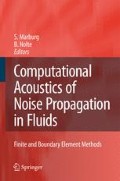Abstract
The energy finite element method was developed to predict the average response of built-up structural acoustic systems consisting of subsystems such as rods, beams, plates, and acoustical enclosures. The methodology for predicting the behavior in the subsystems is based on a diffuse energy field approximation that is most appropriate for high frequency analysis where traditional finite element approaches become expensive. Subsystems are coupled together using net energy flow and energy superposition principles.
Access this chapter
Tax calculation will be finalised at checkout
Purchases are for personal use only
Preview
Unable to display preview. Download preview PDF.
References
Belov VD, Rybak SA (1975) Applicability of the transport equation in the one–dimensional wave–propagation problem. Journal of Soviet Physics–Acoustics 21:110–114
Belov VD, Rybak SA, Tartakovskii BD (1977) Propagation of vibrational energy in absorbing structures. Journal of Soviet Physics–Acoustics 23:115–119
Bitsie F, Bernhard RJ (1998) Sensitivity calculations for structural–acoustic EFEM predictions. Noise Control Engineering Journal 46:91–96
Bouthier OM, Bernhard RJ (1995) Simple models of the energetics of transversely vibrating plates. Journal of Sound and Vibration 182:149–164
Cho PE (1993) Energy flow analysis of coupled structures. PhD Thesis, Purdue University, Herrick Laboratories, West Lafayette
Cho PE, Bernhard RJ (1998) Energy flow analysis of coupled beams. Journal of Sound and Vibration 211:593–605
Franzoni LP, Bliss DB, Rouse JW (2001) An acoustic boundary element method based on energy and intensity variables for predicting broadband sound fields. Journal of the Acoustical Society of America 110:3071–3080
Klos J (2001) Modeling cylindrical shell dynamics using energy flow methods: An analytical and experimental validation. MSME Thesis, School of Mechanical Engineering, Purdue University
Lyon RH, Dejong RG (1995) Statistical energy analysis. Butterworth–Heinemann, Boston, 2nd edition
Nefske DJ, Sung S (1989) Power flow finite element analysis of dynamic systems: Basic theory and application to beams. Journal of Vibration, Acoustics, Stress, and Reliability in Design 111:94–100
Segerlind, LJ (1984) Applied finite element analysis. John Wiley & Sons Inc., New York
Smith MJ (1997) A hybrid energy method for predicting high frequency vibrational response of point–loaded plates. Journal of Sound and Vibration 202:375–394
Versteeg HK, Malalasekera W (1995) An introduction to computational fluid dynamics: the finite volume method. John Wiley & Sons Inc., New York
Vlahopoulos N, Wang A, Wu K (2005) An EFEA formulation for computing the structural response of complex structures. In: Proceedings of 2005 ASME International Mechanical Engineering Congress and Exposition, Orlando
Wang S (2000) High frequency energy flow analysis methods: Numerical implementation, applications, and verification. PhD Thesis, Purdue University, Herrick Laboratories, West Lafayette
Wang S, Bernhard RJ (1999) Energy finite element method (EFEM) and statistical energy analysis (SEA) of a heavy equipment cab. In: Proceedings of SAE 99 Noise & Vibration Conference, Traverse City 443–450
Wang S, Bernhard RJ (1998) The energy finite element method applied to a heavy equipment cab. In: Proceedings of Internoise 98, Christchurch, Paper No. 229
Wang S, Bernhard RJ (2002) Theory and applications of a simplified energy finite element method and its similarity to SEA. Noise Control Engineering Journal 50:63–72
Wang S, Ebbitt G, Powell RE (2002) Development of a generic truck SEA model with EFEA–SEA hybrid exterior. In: Proceedings of the Internoise 2002, Dearborn
Wang A, Vlahopoulos N, Buehrle RD, Klos J (2005) Energy finite element analysis of the NASA aluminum test–bed cylinder. In: Proceedings of 2005 SAE Noise and Vibration Conference, Traverse City, SAE Paper No. 2005-01-2372
Wang A, Vlahopoulos N, Wu K (2004) Development of an energy boundary element formulation for computing high–frequency sound radiation from incoherent intensity boundary conditions. Journal of Sound and Vibration 278:413–436
Wang S, Xu H, Ebbitt G (2001) Sound package optimization using an EFEM0–SEA model for a trimmed van. In: Proceedings of SAE 01 Noise & Vibration Conference, Traverse City
Wohlever JC, Bernhard RJ (1992) Mechanical energy flow models of rods and beams. Journal of Sound and Vibration 153:1–19
Author information
Authors and Affiliations
Editor information
Editors and Affiliations
Rights and permissions
Copyright information
© 2008 Springer-Verlag Berlin Heidelberg
About this chapter
Cite this chapter
Bernhard, R., Wang, S. (2008). Energy Finite Element Method. In: Marburg, S., Nolte, B. (eds) Computational Acoustics of Noise Propagation in Fluids - Finite and Boundary Element Methods. Springer, Berlin, Heidelberg. https://doi.org/10.1007/978-3-540-77448-8_11
Download citation
DOI: https://doi.org/10.1007/978-3-540-77448-8_11
Publisher Name: Springer, Berlin, Heidelberg
Print ISBN: 978-3-540-77447-1
Online ISBN: 978-3-540-77448-8
eBook Packages: Physics and AstronomyPhysics and Astronomy (R0)

